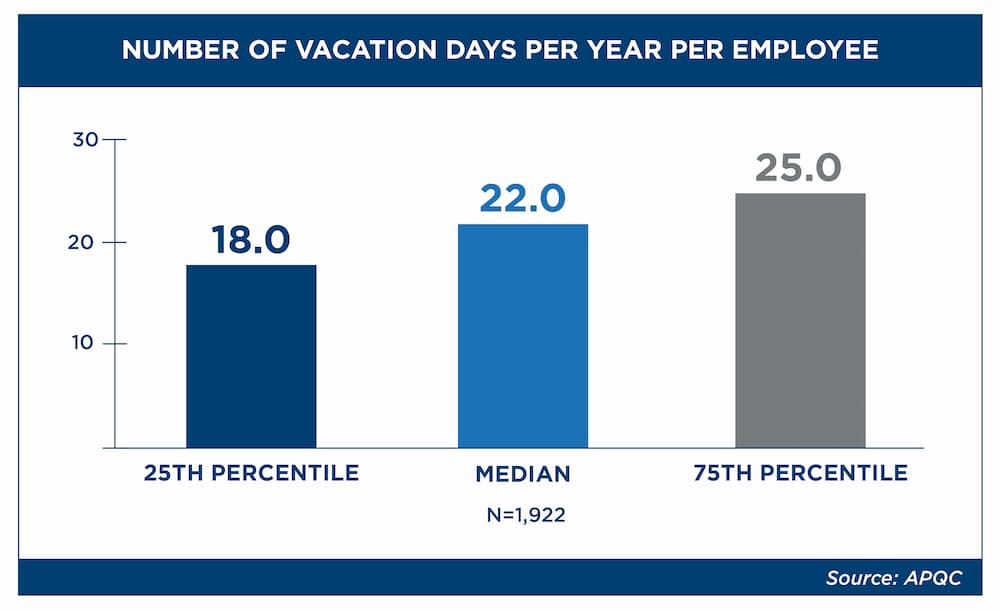The word “productivity” often evokes images related to busyness: A bustling factory floor might come to mind, or a fast-paced law firm. Settings where people get things done quickly and never seem to stop moving.
While it’s not typically the first thing people think of, rest is just as foundational to productivity as action and hustle. Without it, productivity will suffer, along with employee wellbeing and engagement. Unfortunately, many organizations are at higher risk for these outcomes because employees aren’t using their allotted time off or aren’t using it in a restful way.
After breaking down cross-industry data on the number of paid time-off days that organizations offer, we explore some of the most common reasons employees don’t get the rest they need and recommend three broad areas where HR can intervene: culture, policy and planning.
See also: How one company hopes to optimize unused paid leave
Data compiled by the American Productivity & Quality Center shows that organizations provide a median of 22 PTO days per year for each employee. Organizations at the 25th percentile of our dataset provide 18 or fewer PTO days, while those at the 75th percentile provide 25 or more.
We did not find significant differences between industries for this measure. For example, organizations in the consumer products, financial services, government/military, insurance, petroleum/chemical, and retail and wholesale industries all have the same median results as the cross-industry sample.
Union contracts or region-specific laws and regulations may dictate the number of vacation days you need to provide to employees. Otherwise, it’s common for organizations to simply benchmark this measure and either meet or try to exceed the amount of PTO offered by their peers and competitors.
The benefits of PTO for employees and the business
At this point, the benefits of PTO for employee wellbeing are no secret. Numerous studies have shown that well-rested employees are more productive, more creative and healthier—both mentally and physically. Employees who do not take adequate time off can experience elevated stress and anxiety that leads to burnout, disengagement, an increased risk of heart disease and other health impacts.
Employers also pay a price when employees don’t use their time off to rest and recharge. In addition to declining productivity and engagement, organizations could also see increased turnover and increased healthcare costs as overworked employees begin to develop more serious conditions. In some cases, the impact of overwork on employees has led organizations to face significant reputational damage and legal liability. Fostering a healthy PTO ecosystem helps organizations avoid risks like these while keeping their workforce more healthy, happy, engaged and productive.
Barriers to restful PTO
Employees and their organizations benefit in numerous ways when employees take restful time away from work. However, there are significant barriers that often prevent employees from taking the time they need to recharge. For example, researchers have found that time off is most beneficial when employees are completely unplugged from work responsibilities and engaged in physical activity (rather than staring at their phone, for example). This means that PTO will not carry the same benefits if employees are expected to be responsive to messages or calls while they are supposed to be on vacation.
Other common barriers to restful time off include:
- Job insecurity: When employees are worried about losing their jobs, they may try to overperform to prove their value to their employer.
- Unsupportive supervisors: Even if an organization offers unlimited PTO, managers or supervisors often need to approve time away for employees. Without policy guardrails, managers could potentially engage in arbitrary or vindictive decisions around employee PTO.
- Lean staffing or understaffing: This could make PTO difficult for employees to take, even if supervisors are supportive.
- Caretaking responsibilities: Women, in particular, are often expected to play a caregiving role both for children and aging parents. Without dedicated time for these needs, hours taken for caregiving come from the same PTO bank as vacation time.
- Stockpiling: Some employees may plan to save and cash out PTO at the end of their employment tenure.
Any of these scenarios can prevent employees from taking the time they need to rest and recharge in a way that would potentially enhance wellbeing, and by extension, productivity.
Build and sustain an ecosystem that supports restful PTO
Recent survey research shows that workers use less than 40% of their time off for rest and relaxation. The other 60% goes toward activities like running errands, caring for family or doing housework—or doesn’t get used at all. With less than half of PTO going toward restful time off, it also makes sense that 79% of workers feel burned out.
HR is uniquely positioned to build workplace ecosystems that support restful time off and help employees avoid burnout. Below, we describe important interventions that HR can look to in the area of organizational culture, policy and workforce planning.
Build a culture that values time off
Your organizational culture plays a big role in shaping attitudes about time off. For example, hard-charging and competitive business environments are notorious for fostering a culture where it is expected that people will work themselves to exhaustion—often with the risk of burnout or adverse health impacts following closely behind.
To build a culture that values time off, enlist leaders to role model the importance of work-life balance and taking time away from work. Executives and other leaders play an important role in shaping organizational culture because they are highly visible to employees and their example sends a clear message. Support this top-down advocacy with messaging from HR about the value of time off and how employees can use their time off benefits to support their wellbeing.
Support time off with policy
Ideally, your policies around time off should enable employees to use and benefit from PTO, but sometimes policy itself can be an obstacle. If you offer unlimited PTO, for example, it’s important to give clear guidance to managers as well as employees about what time off requests should look like and the conditions under which they should be approved (or not).
More broadly, it’s worth revisiting whether your time off policies are still meeting employee needs and keeping you competitive as an employer. Use employee listening methods like focus groups or an engagement survey to find out how employees tend to use their PTO and whether there are any pain points that you can address with new policies.
Plan for employee time off
Many organizations are under pressure to maintain leaner workforces in order to trim costs. However, it’s a lot more difficult to encourage employees to use their time off when they’re already spread thin and business is disrupted whenever they try to take time away.
To avoid these scenarios, workforce planning needs to be a vital part of your time off ecosystem. Ideally, your staffing should account for employees taking time off and provide enough coverage to avoid significant disruption when employees in key roles step away. If you have access to analytics, use them to discover trends in time off usage and make data-driven decisions around it.
Planning for employee time off also means practicing good knowledge management by creating desktop procedures, process documentation, “how-to” instructions and other knowledge resources so other people can take on tasks related to a specific role if needed. Curate these resources in a place that is easy for employees to access and provide cross-training so employees on the same team can serve as backups for each other.
Key takeaways
Paid time off is vital for a well-rested, healthy and engaged workforce—but simply providing it to employees is not enough. With so many factors pushing employees not to use their time off for rest and relaxation, it’s also important for you to foster a workplace that takes rest seriously.
Building and sustaining a culture with healthy attitudes about time off, supporting time off with clear policy and making sure that teams are adequately staffed will support better work/life balance for employees and also benefit the business because employees will show up ready to do their best work. While it takes time and investment to build this type of workplace ecosystem, it’s going to be less costly in the long run than having high turnover and burned-out employees.
Data in this content was accurate at the time of publication. For the most current data, visit www.apqc.org.
Credit: Source link











